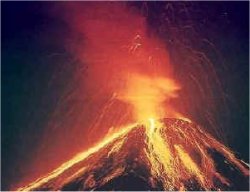
May Editorial
Global worming - lessons from the Earth's history.

May Editorial
Global worming - lessons from the Earth's history.
|
|
Global warming has caught everyone's attention nowadays - from scientists to politicians and general public. Unsurprisingly scientists look for clues about global warming in the Earth's past history. And what better place to look than an event known as the 'Paleocene-Eocene Thermal Maximum' or PETM for short. PETM was an event which happened 55 million years ago at the end of the Paleocene (a geologic epoch that lasted from 65.5 ± 0.3 to 55.8 ± 0.2 million years ago). This extreme global warming event which was the biggest climate change ever recorded in geological history. According to NASA scientists, the change during the PETM was so large that it would have required a decrease in biological activity equivalent to roughly three times the total present-day terrestrial biosphere. In other words, if all of the terrestrial carbon today (in all the forests, animals, people, soils, etc.) were converted to carbon dioxide and returned to the global inorganic carbon pool, the change in the global carbon isotopic ratio would only be a third as big as that observed during the PETM! The PETM lasted 100 thousand years and resulted an increase in sea surface temperature of 5-6oC. In addition, the PETM was accompanied by a very large change to the global carbon cycle as indicated by a large drop in the isotopic ratio of 13C to 12C in the ocean and on land. What caused the PETM has been unclear and a number of hypotheses have been put forward. Most of the evidence pointed to methane as the culprit. We know that large reservoirs of methane existed in the Earth's past and these would be the source of light carbon (12C). Some possible thermal combustion of sedimentary organic matter was also suggested or alternatively, it has been proposed that extensive peat deposits were burned, thus releasing CO2, and that a comet impact triggered the PETM. Another source of CO2 could come from volcanic eruptions - but those would have had to be on a massive scale, and until now most scientists have dismissed that possibility. However, a collaboration between geologists at Roskilde University in Denmark, Oregon State University and Rutgers, The State University of New Jersey has produced evidence which supports the volcanic theory. The scientists examined the spikes in ocean temperatures which happened 55 million years ago and linked them with the massive volcanic eruptions which happened at that time. These eruptions were responsible for the separation of Greenland and northwest Europe, which resulted in the creation of the North Atlantic. To prove that volcanic activity could be responsible for PETM, the scientists used dating techniques to match a layer of volcanic ash that covers ocean floor sediments of ththe time of the PETM with an ash layer in East Greenland and the Faeroes Islands (north of Scotland), where the ash overlies sequences of basaltic lava. These lavas, which form a layered sequence up to seven kilometers thick, are relics of massive flows from the mid-Atlantic ridge and other fissures along which North America and Europe separated. To establish common ages of the PETM-era marine ash layer and the rock formations, the scientists measured the amounts of argon gas trapped in volcanic minerals. That dating method, performed in labs at the three universities, renders precise ages in geological time frames, based on known decay rates of potassium to argon trapped in the volcanic material. They concluded that Intense volcanic activity 55 million years ago occurred at the same time ocean temperatures jumped 5 to 6oC |
| _______________________________ | ||||
| Home | | | Shopping | | | Database |
© Biscuit Software 2004-2015
All rights reserved